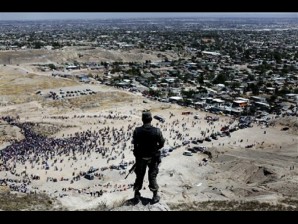
In this April 10, 2009 file photo, a soldier stands guard on the top of a hill as faithful commemorate Good Friday during Holy Week in Ciudad Juarez, Mexico. Killings by criminal gangs in the drug violence-wracked border city of Ciudad Juarez fell by 42 percent in the first six months of this year from the same period of 2011, Mexicoís army said Wednesday July 11, 2012. (AP Photo/Rodrigo Abd)
CIUDAD JUAREZ, Mexico — Killings by criminal gangs in the drug violence-wracked border city of Ciudad Juarez fell by 42 percent in the first six months of this year from the same period of 2011, Mexico’s army said Wednesday.
Gen. Emilio Zarate, the local army commander, attributed the drop to the weakening of the local Juarez drug cartel and the rival Gente Nueva gang, which is allied with the powerful Sinaloa cartel. The two cartels have fought turf battles since 2008 that notoriously made this city across the border from El Paso, Texas the most violent city in Mexico.
Ciudad Juarez recorded 952 killings by gangs in the first half of the year, compared to 1,642 in the first half of 2011, according to Zarate, who said the gangs have been diminished by a multi-pronged offensive that includes army patrols, police reforms and social programs.
He told reporters the Juarez cartel has become so weak that it is having trouble paying its members.
“They have been forced to reorganize and opt for other activities, like kidnapping and extortion,” he said. But he warned that the leaders of the Sinaloa-backed Gente Nueva (or New People) “have economic power because they have constantly received funds from other states.”
Numbers released by the Chihuahua state prosecutors office indicated a similar decline, though its numbers are lower because civilian prosecutors track murders differently. Prosecutors said there were 653 murders in the first half of 2012 and 1,322 in the same period of last year.
More than a transition into peace, drug violence seems to migrate in Mexico, exploding in once-quiet places across the country such as the Gulf coast state of Veracruz and the resort city of Acapulco. When authorities launch an offensive in one spot, violence moves to another. When cartel leaders are arrested, gangs splinter and the resulting offshoot groups fight in areas to control local police and lucrative smuggling corridors.
On Tuesday in the northern border city of Nuevo Laredo, for example, the newspaper El Manana announced that it will stop covering violent criminal disputes after suffering a second grenade attack on its offices in two months. Other northern Mexican newspapers have quietly adopted similar policies of not covering cartel violence to protect their staffs against threats and violent attacks.
President Felipe Calderon claimed in an interview with The Wall Street Journal last month that drug-related killings in Mexico had fallen by roughly 12 percent in the first five months of this year, although he and his administration have refused to release the actual figures of drug-linked homicides since September 2011.
The government’s figures released last fall say more than 47,500 people had died in violence linked to the militarized offensive Calderon launched shortly after taking office in December 2006. Separate federal figures have shown a drop in the overall numbers of homicides in several violence-wracked states, although those statistics do not break out drug-linked killings.
Under its late leader, Amado Carrillo Fuentes, the Juarez cartel became known in the 1990s for flying planeloads of cocaine into the United States, earning Carrillo Fuentes the nickname “The Lord of the Skies.”
Ciudad Juarez’s decline began following his death in 1997, but worsened in the mid-2000s when the Sinaloa cartel sought to move into the city. Sinaloa has largely fought in Ciudad Juarez through proxy local gangs that it hires or finances.
At the height of drug violence in 2010, Ciudad Juarez was seeing an average of about 10 homicides a day, or about 230 murders per 100,000 inhabitants annually. The same year, the average for all of Mexico was 18 per 100,000 people, while in the U.S. the rate was 4.8.
Last year, Calderon said the biggest blow to organized crime in the city was the capture of a former police officer who headed a gang of hitmen for the Juarez cartel. Arrested in July 2011, Jose Antonio Acosta Hernandez, nicknamed “El Diego,” was sentenced to life in prison in a U.S. court in April after he admitted ordering more than 1,500 killings, including the slaying of a U.S. consulate employee in the border city.
Zarate said the number of homicides in the city has averaged about 40 killings a month recently. In past years, Ciudad Juarez sometimes saw as many 300 killing in a month during especially violent periods.
The general said he sees signs that citizens have faith in the army’s anonymous tip service, which allows people to file complaints about drug gangs by phone or email.
He said one sign of the improved security situation is that some businesses that closed in part due to the violence are now reopening. One of the main strips where nightclubs and bars had shut down is now again in full swing with new places opening up and attracting college students from both Ciudad Juarez and El Paso.
“The perception has changed and now we go out and feel calmer, less scared,” said Olga Torres, a 47-year-old housewife who was having lunch with her family at a seafood restaurant near the border.